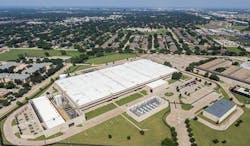Last December, as we looked ahead at the trends that would shape the coming year, Data Center Frontier noted that “2018 is shaping up as a big year for sale-leaseback deals, due to the increased number of properties available and more potential buyers pursuing these types of deals.”
That projection has been borne out, with a growing number of providers using sale-leaseback deals to build national data center portfolios.
An example: Last month Lincoln Rackhouse acquired a 1 million square foot portfolio of data centers from a major financial institution (not named, but clearly Bank of America), which leased back space in two of the three facilities. Lincoln Rackhouse partnered with Principal Real Estate Investors on the transaction, which allowed Lincoln Rackhouse to expand into two new regions of the country.
“This acquisition doubles our portfolio and allows us to offer cloud, colocation and managed services providers attractive expansion or new entry options into these key data center markets,” said Ryan Sullivan, managing director of Dallas-based Lincoln Rackhouse. “We were able to acquire this portfolio because we were patient, flexible and have a proven track record of performance with the seller.”
The Sale-Leaseback Proposition
In a sale-leaseback transaction, an enterprise company sells its data center to a third-party, and then leases the space it needs to operate its existing IT facilities. The buyer, usually an investor or data center service provider, collects the rent and can lease the remaining space.
This type of deal solves a common problem. An enterprise company builds a large data center, assuming its IT operations will grow. It winds up not needing as much space as it expected, due to increased use of virtualization or third-party cloud computing services. As a result, large expanses of expensive data center space sit empty.
The sale-leaseback trend illustrates the diversity of business models in the data center industry. At one end of the spectrum are the massive custom-built greenfield construction projects for cloud providers. At the other end is the sale-leaseback model, which requires expertise in asset selection and retrofits of existing facilities, usually built for enterprises.
Lincoln Rackhouse is executing on this model, bringing new life to data centers that others are seeking to divest. In 2016 it acquired two data centers in Northern Virginia from Netrality Properties, which had just bought them from long-time owner Digital Realty. Lincoln Rackhouse leased the entire building at 1807 Michael Farraday Court in Reston to colocation provider Evocative (which quickly subleased a chunk of the space to Atlantic.Net).
The sale-leaseback trend illustrates the diversity of business models in the data center industry.
The Lincoln Rackhouse model of refurbishing space and leasing to service providers is now being applied to sale-leasebacks. The company’s newly-acquired property in Chandler, Arizona has already been fully leased to colocation provider INAP, which will have Bank of America as an ongoing tenant. Lincoln Rackhouse followed a similar model last year, when it acquired a 5 megawatt data center in Atlanta from Coca-Cola, and then leased the entire facility to INAP, which Coca-Cola remaining as a tenant as it consolidate its remaining IT to other sites.
Lincoln Rackhouse is executing on the strategy it laid out in 2016, when it stepped up its acquisition activity. “The value-add opportunity is the primary play for us,” said Sullivan. “The goal is to pick up several of these opportunities over the next few years.”
Finished Space, Available Now
One benefit of the sale-leaseback model is that these facilities often include surplus finished space that went unused by the enterprise customer. With its recent acquisitions Lincoln Rackhouse now has 8 megawatts of space immediately available to lease in Plano (a northern suburb of Dallas), while its Kansas City facility has 10 megawatts of power capacity and 100,000 sf of raised-floor space ready to occupy.
“We can facilitate a new customer installation next week. That’s extremely rare in today’s white-hot Dallas market,” says Ryan Crabtree, Lincoln Rackhouse’s vice president of asset management and property operations. “As for Kansas City, we now own the largest block of data center space currently available in the market, which historically, has seen more data center development directly by the enterprise, due to a lack of large-scale wholesale data center offerings.”
Another provider using the sale-leaseback model to enter new markets is Iron Mountain, which last year bought Credit Suisse data centers in London and Singapore. Credit Suisse was using just 4.2 megawatts (MW) of the 14 MWs of capacity at the two sites.
In a similar scenario, Ascent bought a pair of data centers in Atlanta and Waterloo, Ontario through through a sale-leaseback deal with an enterprise seller (likely Blackberry). The two buildings offer 13 MW of available space, plus expansion capacity.
Finished Space, Available Now
A growing number of enterprises are putting their data centers on the market, hoping to get out of the business of owning data center real estate. The number of sale-leaseback transactions is trending higher, but buyers have been selective about these opportunities. Many legacy data centers would require significant infrastructure upgrades to be competitive in the multi-tenant data center market.
Several growing data center providers are looking to sale-leaseback model as a way to acquire properties and expand their portfolios.
Chirisia Investments has acquired 21445 Beaumeade Circle, where it will build a 30 megawatt data center inAshburn, Virginia’s Data Center Alley. (Photo: Chirisa Investments)
“We’ve put together a nice offering for sale-leaseback,” said Colm Piercy, the CEO and Founder of Chirisa Investments, which operates the 365 Data Centers, Dataplex and Digital Fortress brands. “I think that will soon account for a lot of our activity. We’re happy to take over the reconditioning of those facilities for what clients want today.”
Chirisa is actively expanding its holdings in the United States, both through its colocation companies and Chirisa Tech Centers, a wholesale data center business that recently acquired a site in Ashburn, Virginia. Piercy says an ideal sale-leaseback scenario is one where the enterprise operator is using 25 to 35 percent of the available space in its data center.
Another company that likes the sale-leaseback model is Element Critical, which is assembling a national platform by acquiring existing data centers in major Internet cities. Like other executives focused on this strategy, Element Critical CEO Ken Parent likes the fact that the sale-leaseback market is not for everyone.
“We’re probably tracking 40 different assets, and none of them are on the market”
Element Critical CEO Ken Parent
“There’s a lot of opportunity, but there’s not a lot of institutional capital behind deals in the legacy space,” said Parent. “There’s enough (property) out there with cash flow.”
It’s a strategy that requires a lot of research, including conversations with property owners who may not believe they are ready to sell.
“It has to be the right asset, in the right market,” said Parent. “We’re probably tracking 40 different assets, and none of them are on the market. These existing assets have to check a lot of boxes.”
Parent, who previously pursued a sale-leaseback growth strategy as CEO of regional provider ByteGrid, believes this approach offers plenty of runway for Element Critical.
“I see us growing this model by two to three assets per year,” he said.






